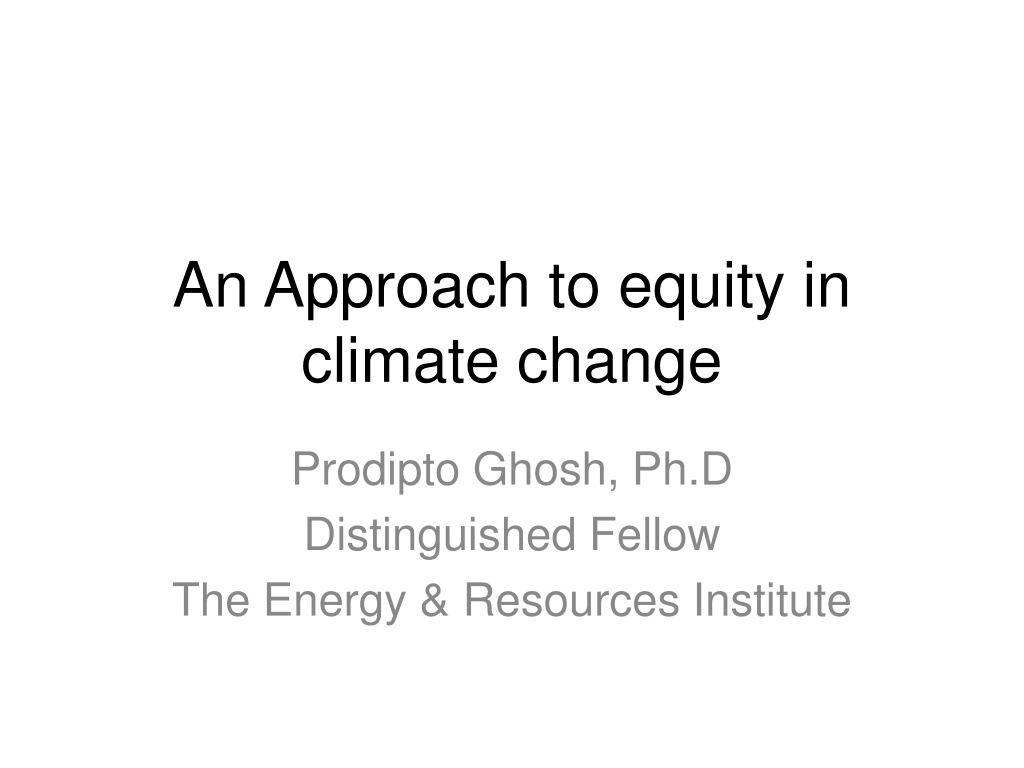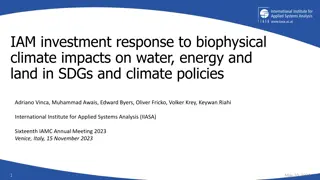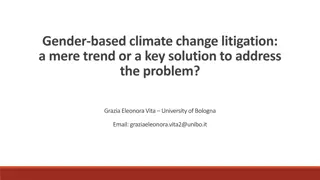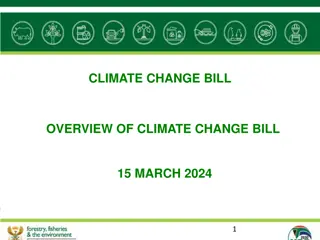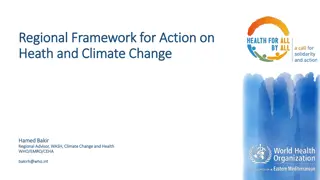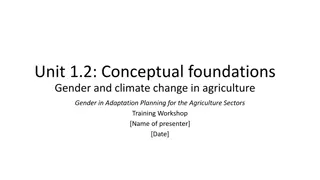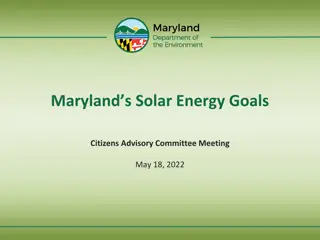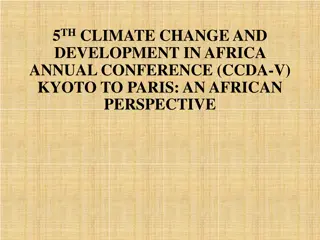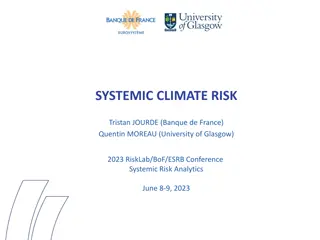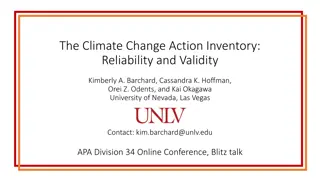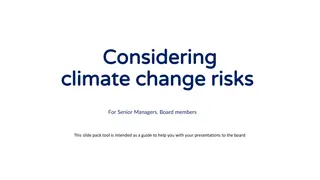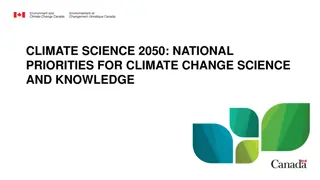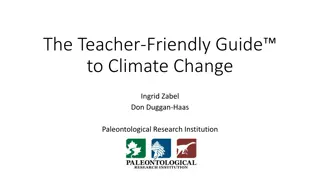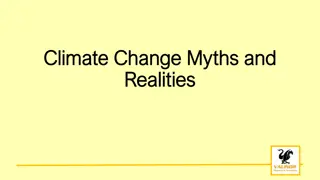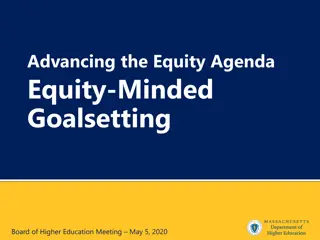Approach to Equity in Climate Change by Prodipto Ghosh, Ph.D.
Prodipto Ghosh's presentation delves into the terrain of equity in climate change, emphasizing obligations of parties in mitigation, adaptation, and resource transfer. The proposed equity norms highlight cooperation, capability-based resource provisions, and ensuring low-capability individuals stay within their environmental entitlements.
Download Presentation

Please find below an Image/Link to download the presentation.
The content on the website is provided AS IS for your information and personal use only. It may not be sold, licensed, or shared on other websites without obtaining consent from the author.If you encounter any issues during the download, it is possible that the publisher has removed the file from their server.
You are allowed to download the files provided on this website for personal or commercial use, subject to the condition that they are used lawfully. All files are the property of their respective owners.
The content on the website is provided AS IS for your information and personal use only. It may not be sold, licensed, or shared on other websites without obtaining consent from the author.
E N D
Presentation Transcript
An Approach to equity in climate change Prodipto Ghosh, Ph.D Distinguished Fellow The Energy & Resources Institute
The Terrain of Equity in Climate Change Securing the interest (and involvement of) future generations Obligations of Parties in relation to GHG mitigation, Obligations of Parties in relation to Adaptation to impacts of climate change Obligations of Parties wrt loss of livelihoods owing to GHG mitigation actions by others Obligations and entitlements of Parties wrt transfer of finances and technology Climate change obligations need to be realized on the basis of equity, if the arrangements are to have wide political acceptability, and hence sustainability in practice. 2
Theme of this presentation: Rival ethical norms are typically advocated in approaches to policy making in specific areas we need a methodology to adjudge which of these norms are not invalid . A particular ethical norm is proposed to address the different dimensions of climate change, and subjected to this test of invalidation. 3
Proposed equity norm Proposition 1: All humans should cooperate in securing the Ultimate Objective in respect of the global climate (furnished in Art 2 of the UNFCCC), the terms of such cooperation being as follows: Proposition 2: In respect of persons of low capability, in order to remedy the residual damage of climate change impacts (i.e. when the Ultimate Objective is met), persons of high capability should provide resources and technology in proportion to their respective capabilities. Note: The residual damage may be within or external to a given country. The point is that the obligation of a country to remedy the damage depends only upon its respective capability. Thus, a poor country, with little capability, but high climate damage would be entitled to transfer of resources from others with high capability. 4
Equity norm Proposition 3: In respect of persons of low capability, in order to enable such persons to remain within their assigned entitlements to the global environmental resources while continuing to develop unfettered, persons of high capability should provide resources and technology in proportion to their respective capabilities. Proposition 4: In respect of harm to persons of low capability beyond residual damage i.e. when the Ultimate Objective is not met, persons who have exceeded their respective shares of the global environmental resource and have high capability must remedy such excess harm in proportion to the extent to which they have exceeded their respective entitlements. 5
Equity norm Proposition 5: In respect of those with low capability whose livelihoods are adversely affected by the actions of others to mitigate GHG emissions, assistance towards alternative livelihoods must be provided by those with high capability in proportion to their respective capabilities.. Proposition 6: All human beings have equal entitlements to global environmental resources. Each person is the legatee of her parents, and carries their undischarged obligations as well as their unused entitlements. They may exchange these entitlements/obligations by mutual, prior, informed consent. These entitlements/obligations, in the aggregate are limited by the Ultimate Objective of the Climate Change Convention. The context, of course, is global society comprised of sovereign states, in turn comprised of, and representing human beings. Thus the actual locus of the Propositions will be sovereign states, rather than individuals. 6
Methodology The methodology derives from Karl Popper s (1968) critical rationalist philosophy of science which holds that the growth of scientific knowledge occurs through deliberate attempts to falsify, rather than confirm, proposed hypotheses. A hypothesis proceeds to the status of a theory after surviving repeated tests of falsification. 7
MacRae MacRae attempts to formalize in ethical theory the accepted canons of the scientific method. There is wide agreement that the scientific method comprises of the following steps: Formal statement of candidate hypotheses to explain observed empirical phenomenon in respect of a given domain in advance. Demonstrating that the hypotheses relate to the entire body of empirical phenomenon in the given domain. Demonstrating that the hypotheses are consistent with accepted general laws . Demonstration of consistency of the candidate hypothesis with observed empirical phenomenon in the given domain. Peer review, publication, and open debate about the candidate hypotheses. Candidate hypotheses that survive these tests are taken as not falsified . 1. 2. 3. 4. 5. 6. 8
Reflective Equilibrium MacRae s technique requires that widely shared ethical intuitions must be reconciled with ethical norms (hypotheses). Reconciliation of widely shared ethical beliefs with a theoretical structure that may unify and justify these beliefs is known as the technique of reflective equilibrium (originally described in Rawls: A Theory of Justice) 9
MacRaes Technique MacRae s technique is a procedure with the following steps: (i) specification of candidate ethical hypotheses in advance; (ii) application of common standards of assessment, comprising: (a) (lack of) generality, i.e. the candidate hypothesis does not apply to a situation in which people have ethical convictions; (b) (Lack of) Internal consistency, i.e. the hypothesis makes contradictory prescriptions in particular situations; (c) external consistency, i.e. consistency with widely shared ethical intuitions. 10
Steps in the new methodology adopted: Specification: The candidate ethical hypotheses are specified by the protagonists in advance. Test of domain: The candidate ethical norm must apply to all situations which relate to the proposed domain of policy-making. In respect of climate change policy, I define the relevant domain as comprising relevant provisions of Art 2 and Art 4 of the UNFCCC. Adherence to pre-specified (meta) ethical criteria: The identification of a set of mutually consistent (meta) ethical criteria with which all candidate hypotheses should be demonstrably consistent. Different criteria would apply to deontological and teleological ethical hypotheses and comprise substantive requirements of the ethical norms. 11
Meta-ethical criteria The set of criteria are specified as follows: Teleological ethics: These are the well-known Arrow s conditions, together with a relevant formulation of the Principle of Universalizability: The Pareto Principle: If everyone prefers societal state A to societal state B, then state A must be ranked higher to state B. Independence of irrelevant alternatives: Whether state A is better than state B of society should depend only upon how individuals have preferences between states A and B, and not depend upon their preferences over some other state C. Unrestricted domain: The ethical norm must hold for all logically possible sets of evaluations (preferences over) societal states. 12
Meta-ethical criteria Non-dictatorship: The ethical ordering cannot automatically be taken to be the same as that of one individual s preference irrespective of the evaluations of others. (Relevant form of) Principle of Universalizability: Inter- changeability of individuals between particular societal positions without affecting the relative ranking of societal states. Of course, the standard rationality conditions (comparability and transitivity) would also apply, i.e. for every pair of societal states A and B, only one of the following can be true: A > B, or A < B, or A = B. If A = B, and C = B, then A = C. 13
Meta-ethical criteria Deontological ethics: The principles adopted are the following: Principle of Universalizability: If some predicate P belongs to some subject S because S has some quality Q (where possession of Q is necessary and sufficient reason), then logically P must belong to all other subjects S1, S2, S3 .Sn that have Q. The corollary is that since Q is both necessary and sufficient reason, predicate P must not belong to any Sj that does not possess Q. Additionally, material deontological norms should adhere to thecriteria set forth below: Pluralistic criteria: These include: (i) keeping promises, i.e. discharging one s obligations in express or implied contracts, (ii) repaying benefits received from others (whether individuals or community or other societal institutions), if not given as a gift, and not declined; and (iii) avoiding (uncompensated) harm to innocent persons. Monistic criterion: The Principle of Consent, i.e. an action is obligatory if the person who has accepted the obligation has done so voluntarily, expressly or by implication. 14
Meta-ethical criteria Both teleological and deontological: External consistency: Reflective Equilibrium: The candidate ethical hypotheses must support widely shared ethical beliefs in the given domain. MacRae allows the disputants to generate ethical convictions as the debate proceeds, and adjustment of the candidate ethical hypothesis. I too require the specification of a set of shared ethical convictions upfront, and also permit adjustment of the proposed ethical hypotheses. 15
Shared ethical convictions: Specification of the shared ethical convictions: 1. Thou shalt not steal : In a society it is impermissible for anyone to divest others of their valued goods at their personal discretion, except that the former need it for life or basic sustenance. 2. No slavery : Voluntary contracts for the supply of inputs to production by others must be the norm. 3. Polluters pay : Victims of harm committed by others must be compensated by the perpetrators. 4. Poverty, (i.e. serious material and intellectual deprivation), must be eradicated. 5. No unique human cultural group must be driven to (cultural) extinction. 16
Final steps Peer review, publication, and open debate about rival hypotheses: The results of the tests should be subject to peer review, publication and open debate. Survivor(s): The candidate ethical hypotheses that survive all three tests in the methodology would then count as not invalidated. 17
Further questions How is capability to be defined? Further, are gradations intermediate between low and high capability necessary? How are GHG emissions of a country to be reckoned? Do they refer to all emissions which physically occur within the borders of a country, or do they relate only to emissions related to goods and services consumed, and investments made, within a country? From what date does one reckon that historical responsibility starts? 18
The Scientific Method, which our methodology emulates, requires open debate about alternative hypotheses. This presentation is intended to start, not end the debate! 19
Thank You 20
